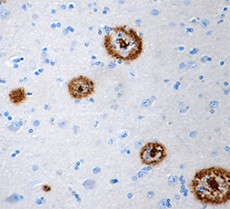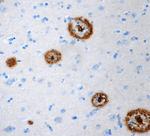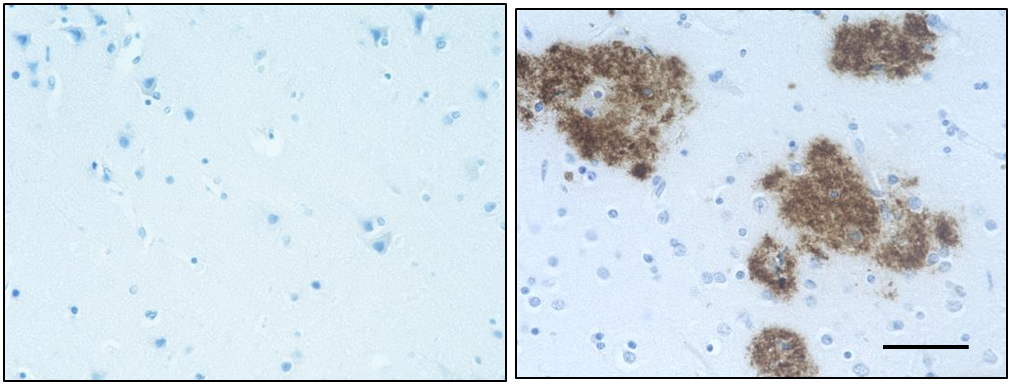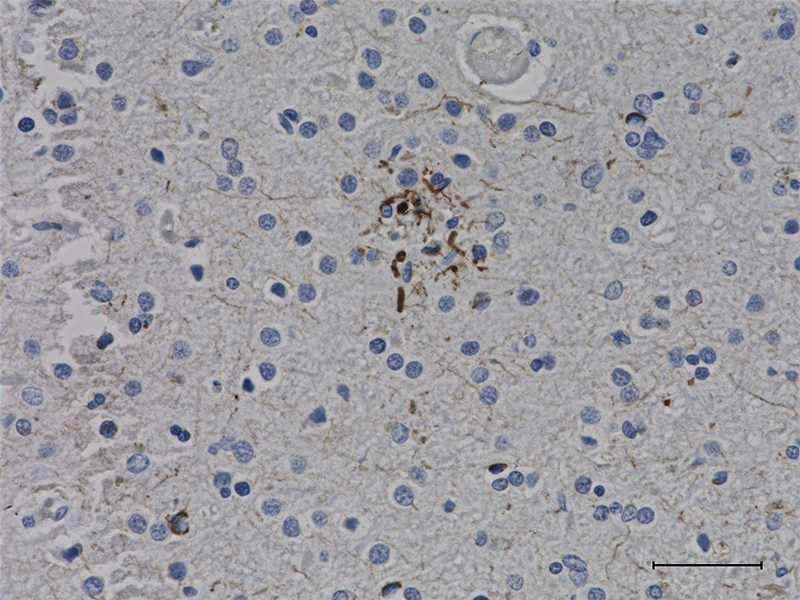- Clone
- NAB 228 (See other available formats)
- Regulatory Status
- RUO
- Other Names
- Amyloid beta A4 protein, preA4, protease nexin-II, peptidase nexin-II, beta-amyloid peptide, alzheimer disease amyloid protein, cerebral vascular amyloid peptide, APP, Amyloid Precursor Protein
- Isotype
- Mouse IgG2a, κ
- Ave. Rating
- Submit a Review
- Product Citations
- publications

-

IHC staining of anti-β-Amyloid, 1-11 antibody (clone NAB 228) on formalin-fixed paraffin-embedded human Alzheimer's disease neocortical brain tissue. After antigen retrieval using 70% Formic Acid for 20 minutes, the tissue was incubated with the primary antibody at 10 µg/ml for 24 hours at 4°C. BioLegend's Ultra Streptavidin (USA) HRP Detection Kit was used for detection followed by hematoxylin counterstaining.
| Cat # | Size | Price | Quantity Check Availability | Save | ||
|---|---|---|---|---|---|---|
| 835104 | 100 µg | 221€ | ||||
Alzheimer’s disease is characterized by the accumulation of aggregated Aβ peptides in senile plaques and vascular deposits. Aβ peptides are derived from amyloid precursor proteins (APPs) through sequential proteolytic cleavage of APP by β-secretases and γ-secretases generating diverse species of Aβ with differential propensities to fibrillize and deposit in Senile Plaques.
According to the UniProtKB database, APP (ID# P05067) has 11 isoforms (34 to ~90 kD). The 770 amino acid form (APP770) has been designated as the canonical form. Isoform APP695 is the predominant form expressed in neuronal tissue. Isoforms APP751 and APP770 are widely expressed in non-neuronal cells. Isoform APP751 is the most abundant form in T-lymphocytes.
Product Details
- Verified Reactivity
- Human
- Antibody Type
- Monoclonal
- Host Species
- Mouse
- Immunogen
- This antibody was raised against a peptide sequence corresponding to amino acids 1-11 of human amyloid beta (Aβ) protein.
- Formulation
- Phosphate-buffered solution, pH 7.2, containing 0.09% sodium azide.
- Preparation
- The antibody was purified by affinity chromatography.
- Concentration
- 0.5 mg/ml
- Storage & Handling
- The antibody solution should be stored undiluted between 2°C and 8°C.
- Application
-
IHC-P - Quality tested
ELISA Detection - Verified
IP, WB - Reported in the literature, not verified in house - Recommended Usage
-
Each lot of this antibody is quality control tested by formalin-fixed paraffin-embedded immunohistochemical staining. For immunohistochemistry, a concentration range of 0.5 - 5.0 µg/ml is suggested. For ELISA Detection, a concentration range of 25 - 50 ng/ml is recommended. It is recommended that the reagent be titrated for optimal performance for each application.
- Application Notes
-
Additional reported applications (for the releavant formats) include immunoprecipication4, Western blotting1,2,4,9, and immunoflurescence microscopy7.
NAB 228 recognizes a peptide corresponding to amino acid residues 1-11 of the human amyloid beta (Aß) as determined by ELISA using peptides that block its immunoreactivity. This antibody also recognizes full length amyloid precursor protein (APP), soluble APP form (sAPPa), C99 cleavage form, and Aß (1-40 and 1-42). NAP 228 does not recognize sAPPß.
This antibody can be used to stain amyloid plaques (diffuse and compact) and amyloid angiopathy on formalin-fixed paraffin-embedded tissue (human AD, Downs syndrome, MCI and transgenic mouse). - Application References
-
- Lee EB, et al. 2003. J. Biol. Chem. 278(7):4458-66. (WB) PubMed
- Mandler M, et al. 2015. PLoS One 1:e0115237. (WB) PubMed
- Wolk DA, et al. 2011. Arch. Neurol. 11:1398. (IHC) PubMed
- Lee EB, et al. 2006. J. Biol. Chem. 7:4292. (IP, WB, IHC) PubMed
- Berlau DJ, et al. 2013. Alzheimers Dement. 6:699. (IHC) PubMed
- Robinson JL, et al. 2014. Brain 137:2578. (IHC) PubMed
- Carroll JC, et al. 2011. J. Neurosci. 40:14436. (IHC, IF) PubMed
- Hurtado DE, et al. 2010. Am. J. Pathol. 4:1977. (IHC) PubMed
- Lee EB, et al. 2005. J. Cell Biol. 2:291. (IHC, WB) PubMed
- RRID
-
AB_2632642 (BioLegend Cat. No. 835104)
Antigen Details
- Structure
- Amyloid precursor protein is a 770 amino acid protein with a molecular mass of approximately 90 kD. Aß denotes peptides of 36-43 amino acids generated from cleavage of APP by secretases. Aß has an apparent molecular mass of about 4 kD.
- Distribution
-
Cellular distribution: cytosol, extracellular, endosomes, golgi apparatus.
- Biology Area
- Cell Biology, Neurodegeneration, Neuroscience, Protein Misfolding and Aggregation
- Molecular Family
- APP/β-Amyloid
- Gene ID
- 351 View all products for this Gene ID
- UniProt
- View information about beta-Amyloid 1-11 on UniProt.org
Related Pages & Pathways
Pages
Related FAQs
Other Formats
View All β-Amyloid, 1-11 Reagents Request Custom Conjugation| Description | Clone | Applications |
|---|---|---|
| Purified anti-β-Amyloid, 1-11 | NAB 228 | IHC-P,ELISA Detection,IP,WB |
Customers Also Purchased
Compare Data Across All Formats
This data display is provided for general comparisons between formats.
Your actual data may vary due to variations in samples, target cells, instruments and their settings, staining conditions, and other factors.
If you need assistance with selecting the best format contact our expert technical support team.
-
Purified anti-β-Amyloid, 1-11

IHC staining of anti-β-Amyloid, 1-11 antibody (clone NAB 228...

 Login / Register
Login / Register 











Follow Us